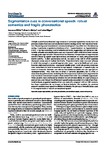Segmentation cues in spontaneous speech: Robust semantics and fragile phonotactics.
| dc.contributor.author | White, L | en |
| dc.contributor.author | Mattys, SL | en |
| dc.contributor.author | Wiget, L | en |
| dc.date.accessioned | 2018-08-13T15:32:56Z | |
| dc.date.available | 2018-08-13T15:32:56Z | |
| dc.date.issued | 2012 | en |
| dc.identifier.other | 375 | en |
| dc.identifier.uri | http://hdl.handle.net/10026.1/12128 | |
| dc.description.abstract |
Multiple cues influence listeners’ segmentation of connected speech into words, but most previous studies have used stimuli elicited in careful readings rather than natural conversation. Discerning word boundaries in conversational speech may differ from the laboratory setting. In particular, a speaker’s articulatory effort – hyperarticulation vs. hypoarticulation (H&H) – may vary according to communicative demands, suggesting a compensatory relationship whereby acoustic-phonetic cues are attenuated when other information sources strongly guide segmentation.We examined how listeners’ interpretation of segmentation cues is affected by speech style (spontaneous conversation vs. read), using cross-modal identity priming. To elicit spontaneous stimuli, we used a map task in which speakers discussed routes around stylized landmarks. These landmarks were two-word phrases in which the strength of potential segmentation cues – semantic likelihood and crossboundary diphone phonotactics – was systematically varied. Landmark-carrying utterances were transcribed and later re-recorded as read speech. Independent of speech style, we found an interaction between cue valence (favorable/unfavorable) and cue type (phonotactics/semantics). Thus, there was an effect of semantic plausibility, but no effect of cross-boundary phonotactics, indicating that the importance of phonotactic segmentation may have been overstated in studies where lexical information was artificially suppressed. These patterns were unaffected by whether the stimuli were elicited in a spontaneous or read context, even though the difference in speech styleswas evident in a main effect. Durational analyses suggested speaker-driven cue trade-offs congruent with an H&H account, but these modulations did not impact on listener behavior. We conclude that previous research exploiting read speech is reliable in indicating the primacy of lexically based cues in the segmentation of natural conversational speech. | en |
| dc.language.iso | en | en |
| dc.title | Segmentation cues in spontaneous speech: Robust semantics and fragile phonotactics. | en |
| dc.type | Journal Article | |
| plymouth.volume | 3 | en |
| plymouth.journal | Frontiers in Cognition | en |
| plymouth.organisational-group | /Plymouth | |
| plymouth.organisational-group | /Plymouth/REF 2021 Researchers by UoA | |
| plymouth.organisational-group | /Plymouth/REF 2021 Researchers by UoA/UoA04 Psychology, Psychiatry and Neuroscience | |
| plymouth.organisational-group | /Plymouth/REF 2021 Researchers by UoA/UoA04 Psychology, Psychiatry and Neuroscience/UoA04 Psychology, Psychiatry and Neuroscience MANUAL | |
| dc.rights.embargoperiod | Not known | en |
| rioxxterms.licenseref.uri | http://www.rioxx.net/licenses/all-rights-reserved | en |
| rioxxterms.type | Journal Article/Review | en |


